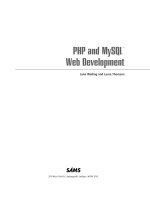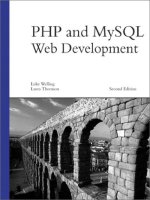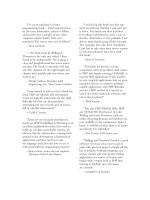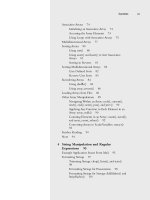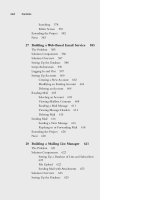php and mysql web development, second edition
Bạn đang xem bản rút gọn của tài liệu. Xem và tải ngay bản đầy đủ của tài liệu tại đây (7.77 MB, 913 trang )
“I’ve never purchased a better
programming book… This book proved to
be the most informative, easiest to follow,
and had the best examples of any other
computer-related book I have ever
purchased.The text is very easy to follow!”
—Nick Landman
“…the Sams book by Welling &
Thomson is the only one which I have
found to be indispensable.The writing is
clear and straightforward but never wastes
my time.The book is extremely well laid
out.The chapters are the right length and
chapter titles quickly take you where you
want to go.”
—Wright Sullivan, President,A&E
Engineering, Inc., Greer South Carolina
“I just wanted to tell you that I think the
book PHP and MySQL Web Development
rocks! It’s logically structured, just the right
difficulty level for me (intermediate),
interesting and easy to read, and, of course,
full of valuable information!”
—CodE-E, Austria
“There are several good introductory
books on PHP, but Welling & Thomson is an
excellent handbook for those who wish to
build up complex and reliable systems. It’s
obvious that the authors have a strong back-
ground in the development of professional
applications and they teach not only
the language itself, but also how to use it
with good software engineering practices.”
—Javier Garcia, senior telecom engineer,
Telefonica R&D Labs, Madrid
“I picked up this book two days ago
and I am half way finished. I just can’t put
it down.The layout and flow is perfect.
Everything is presented in such a way so
that the information is very palatable. I am
able to immediately grasp all the concepts.
The examples have also been wonderful.
I just had to take some time out to express
to you how pleased I have been with
this book.”
—Jason B. Lancaster
“This book has proven a trusty
companion, with an excellent crash course
in PHP and superb coverage of MySQL as
used for Web applications. It also features
several complete applications that are great
examples of how to construct modular,
scalable applications with PHP.Whether
you are a PHP newbie or a veteran in
search of a better desk-side reference, this
one is sure to please!”
—WebDynamic
“The true PHP/MySQL bible, PHP
and MySQL Web Development by Luke
Welling and Laura Thomson, made me
realize that programming and databases are
now available to the commoners. Again, I
know 1/10000th of what there is to know,
and already I’m enthralled.”
—Tim Luoma,TnTLuoma.com
“Welling and Thomson’s book is a good
reference for those who want to get to
grips with practical projects straight off the
bat. It includes webmail, shopping cart,
session control, and web-forum/weblog
applications as a matter of course, and
begins with a sturdy look at PHP first,
moving to MySQL once the basics
are covered.”
—twilight30 on Slashdot
00 525x fm 1/24/03 2:56 PM Page i
“This book is absolutely excellent, to
say the least…. Luke Welling and Laura
Thomson give the best in-depth explana-
tions I’ve come across on such things as
regular expressions, classes and objects,
sessions etc. I really feel this book filled in a
lot of gaps for me with things I didn’t quite
understand….This book jumps right into
the functions and features most commonly
used with PHP, and from there it continues
in describing real-world projects, MySQL
integration, and security issues from a proj-
ect manager’s point of view. I found every
bit of this book to be well organized and
easy to understand.”
—notepad on codewalkers.com
“A top-notch reference for
programmers using PHP and MySQL.
Highly recommended.”
—The Internet Writing Journal
“This book rocks! I am an experienced
programmer, so I didn’t need a lot of help
with PHP syntax; after all, it’s very close to
C/C++. I don’t know a thing about
databases, though, so when I wanted to
develop a book review engine (among
other projects) I wanted a solid reference
to using MySQL with PHP. I have
O’Reilly’s mSQL and MySQL book, and
it’s probably a better pure-SQL reference,
but this book has earned a place on my
reference shelf…Highly recommended.”
—Paul Robichaux
“One of the best programming guides
I’ve ever read.”
—jackofsometrades from Lahti, Finland
“This is a well-written book for learn-
ing how to build Internet applications with
two of the most popular open-source Web
development technologies….The projects
are the real jewel of the book. Not only are
the projects described and constructed in a
logical, component-based manner, but the
selection of projects represents an excellent
cross-section of common components that
are built into many web sites.”
—Craig Cecil
“The book takes an easy, step-by-step
approach to introduce even the clueless
programmer to the language of PHP. On
top of that, I often find myself referring
back to it in my Web design efforts. I’m still
learning new things about PHP, but this
book gave me a solid foundation from
which to start and continues to help me to
this day.”
—Stephen Ward
“This book is one of few that really
touched me and made me ‘love’ it. I can’t
put it in my bookshelf; I must put it in a
touchable place on my working bench as I
always like to refer from it. Its structure is
good, wordings are simple and straight for-
ward, and examples are clear and step by
step. Before I read it, I knew nothing of
PHP and MySQL. After reading it, I have
the confidence and skill to develop any
complicated Web application.”
—Power Wong
“This book is God…. I highly recom-
mend this book to anyone who wants to
jump in the deep end with database driven
Web application programming. I wish more
computer books were organized this way.”
—Sean C Schertell
00 525x fm 1/24/03 2:56 PM Page ii
PHP and MySQL
Web Development
Sams Publishing, 201 West 103rd Street, Indianapolis, Indiana 46290
DEVELOPER’S
LIBRARY
Luke Welling
Laura Thompson
Second Edition
00 525x fm 1/24/03 2:56 PM Page iii
PHP and MySQL Web Development
Second Edition
Copyright 2003 by Sams Publishing
All rights reserved. No part of this book shall be reproduced, stored
in a retrieval system, or transmitted by any means, electronic,
mechanical, photocopying, recording, or otherwise, without written
permission from the publisher. No patent liability is assumed with
respect to the use of the information contained herein. Although
every precaution has been taken in the preparation of this book, the
publisher and author assume no responsibility for errors or omis-
sions. Neither is any liability assumed for damages resulting from the
use of the information contained herein.
International Standard Book Number: 0-672-32525-X
Library of Congress Catalog Card Number: 2002115573
Printed in the United States of America
First Printing: February 2003
06 05 04 03 4 3 2 1
Trademarks
All terms mentioned in this book that are known to be trademarks
or service marks have been appropriately capitalized. Sams
Publishing cannot attest to the accuracy of this information. Use of a
term in this book should not be regarded as affecting the validity of
any trademark or service mark.
Wa r ning and Disclaimer
Every effort has been made to make this book as complete and as
accurate as possible, but no warranty or fitness is implied.The infor-
mation provided is on an “as is” basis.The authors and the publisher
shall have neither liability nor responsibility to any person or entity
with respect to any loss or damages arising from the information
contained in this book or from the use of the CD-ROM or pro-
grams accompanying it.
Acquisitions Editor
Shelley Johnston
Development Editor
Scott Meyers
Managing Editor
Charlotte Clapp
Copy Editors
Seth Kerney
Rhonda Tinch-Mize
Indexers
Kelly Castell
Mandie Frank
Proofreader
Suzanne Thomas
Technical Editor
Chris Newman
Media Specialist
Dan Scherf
Cover Design
Alan Clements
Production
Michelle Mitchell
00 525x fm 1/24/03 2:56 PM Page iv
❖
To our Mums and Dads
❖
00 525x fm 1/24/03 2:56 PM Page v
Overview
Introduction 1
I Using PHP
1 PHP Crash Course 11
2 Storing and Retrieving Data 51
3 Using Arrays 71
4 String Manipulation and Regular Expressions 95
5 Reusing Code and Writing Functions 117
6 Object-Oriented PHP 145
II Using MySQL
7 Designing Your Web Database 169
8 Creating Your Web Database 181
9 Working with Your MySQL Database 203
10 Accessing Your MySQL Database from the Web with
PHP 223
11 Advanced MySQL 241
III E-commerce and Security
12 Running an E-commerce Site 261
13 E-commerce Security Issues 273
14 Implementing Authentication with PHP and
MySQL 293
15 Implementing Secure Transactions with PHP and
MySQL 315
00 525x fm 1/24/03 2:56 PM Page vi
IV Advanced PHP Techniques
16 Interacting with the File System and the Server
337
17 Using Network and Protocol Functions 357
18 Managing the Date and Time 379
19 Generating Images 387
20 Using Session Control in PHP 413
21 Other Useful Features 429
V Building Practical PHP and MySQL Projects
22 Using PHP and MySQL for Large Projects 439
23 Debugging 455
24 Building User Authentication and Personalization
473
25 Building a Shopping Cart 511
26 Building a Content Management System 555
27 Building a Web-Based Email Service 585
28 Building a Mailing List Manager 621
29 Building Web Forums 675
30 Generating Personalized Documents in Portable
Document Format (PDF) 705
31 Connecting to Web Services with XML and SOAP
739
VI Appendixes
A Installing PHP and MySQL 789
B Web Resources 813
Index 817
00 525x fm 1/24/03 2:56 PM Page vii
Table of Contents
I Using PHP
1 PHP Crash Course 11
Using PHP 12
Sample Application: Bob’s Auto Parts 12
The Order Form 12
Processing the Form 14
Embedding PHP in HTML 14
Using PHP Tags 16
PHP Tag Styles 16
PHP Statements 17
Whitespace 17
Comments 18
Adding Dynamic Content 18
Calling Functions 19
The date() Function 19
Accessing Form Variables 20
Form Va r iables 20
String Concatenation 22
Va r iables and Literals 23
Identifiers 24
User Declared Variables 24
Assigning Values to Variables 24
Va r iable Types 25
PHP’s Data Types 25
Type Strength 25
Type Casting 26
Va r iable Variables 26
Constants 26
00 525x fm 1/24/03 2:56 PM Page viii
Va r iable Scope 27
Operators 28
Arithmetic Operators 28
String Operators 29
Assignment Operators 29
Comparison Operators 32
Logical Operators 33
Bitwise Operators 33
Other Operators 34
Using Operators:Working Out the Form Totals 35
Precedence and Associativity: Evaluating Expressions 37
Va r iable Functions 38
Testing and Setting Variable Types 38
Testing Variable Status 39
Re-interpreting Variables 39
Control Structures 40
Making Decisions with Conditionals 40
if Statements 40
Code Blocks 40
A Side Note: Indenting Your Code 41
else Statements 41
elseif Statements 42
switch Statements 43
Comparing the Different Conditionals 44
Iteration: Repeating Actions 45
while Loops 46
for and foreach Loops 47
do while Loops 48
Breaking Out of a Control Structure or Script 49
Next: Saving the Customer’s Order 49
2 Storing and Retrieving Data 51
Saving Data for Later 51
Storing and Retrieving Bob’s Orders 52
Overview of File Processing 53
00 525x fm 1/24/03 2:56 PM Page ix
x
Contents
Opening a File 53
File Modes 53
Using fopen() to Open a File 54
Opening Files Through FTP or HTTP 56
Problems Opening Files 56
Writing to a File 59
Parameters for fwrite() 59
File Formats 59
Closing a File 60
Reading from a File 60
Opening a File for Reading: fopen() 62
Knowing When to Stop: feof() 62
Reading a Line at a Time: fgets(), fgetss(), and
fgetcsv() 62
Reading the Whole File: readfile(), fpassthru(),
file() 63
Reading a Character: fgetc() 64
Reading an Arbitrary Length: fread() 64
Other Useful File Functions 65
Checking Whether a File Is There: file_exists()
65
Knowing How Big a File Is: filesize() 65
Deleting a File: unlink() 65
Navigating Inside a File: rewind(), fseek(), and
ftell() 65
File Locking 66
Doing It a Better Way: Database Management Systems
68
Problems with Using Flat Files 68
How RDBMSs Solve These Problems 69
Further Reading 69
Next 69
3 Using Arrays 71
What Is an Array? 71
Numerically Indexed Arrays 72
Initializing Numerically Indexed Arrays 72
Accessing Array Contents 73
Using Loops to Access the Array 74
00 525x fm 1/24/03 2:56 PM Page x
xi
Contents
Associative Arrays 74
Initializing an Associative Array 74
Accessing the Array Elements 74
Using Loops with Associative Arrays 75
Multidimensional Arrays 77
Sorting Arrays 80
Using sort() 80
Using asort() and ksort() to Sort Associative
Arrays 81
Sorting in Reverse 81
Sorting Multidimensional Arrays 82
User Defined Sorts 82
Reverse User Sorts 83
Reordering Arrays 84
Using shuffle() 84
Using array_reverse() 86
Loading Arrays from Files 86
Other Array Manipulations 89
Navigating Within an Array: each(), current(),
reset(), end(), next(), pos(), and prev() 90
Applying Any Function to Each Element in an
Array: array_walk() 90
Counting Elements in an Array: count(), sizeof(),
and array_count_values() 92
Converting Arrays to Scalar Variables: extract()
92
Further Reading 94
Next 94
4 String Manipulation and Regular
Expressions 95
Example Application: Smart Form Mail 95
Formatting Strings 97
Tr imming Strings: chop(), ltrim(), and trim()
98
Formatting Strings for Presentation 98
Formatting Strings for Storage: AddSlashes() and
StripSlashes() 101
00 525x fm 1/24/03 2:56 PM Page xi
xii
Contents
Joining and Splitting Strings with String Functions
103
Using explode(), implode(), and join() 103
Using strtok() 104
Using substr() 104
Comparing Strings 105
String Ordering: strcmp(),strcasecmp(), and str-
natcmp() 105
Testing String Length with strlen() 106
Matching and Replacing Substrings with String
Functions 106
Finding Strings in Strings: strstr(), strchr(), str-
rchr(), stristr() 107
Finding the Position of a Substring: strpos(), str-
rpos() 107
Replacing Substrings: str_replace(),
substr_replace() 108
Introduction to Regular Expressions 109
The Basics 110
Character Sets and Classes 110
Repetition 112
Subexpressions 112
Counted Subexpressions 112
Anchoring to the Beginning or End of a String
112
Branching 113
Matching Literal Special Characters 113
Summary of Special Characters 113
Putting It All Together for the Smart Form 114
Finding Substrings with Regular Expressions 115
Replacing Substrings with Regular Expressions 115
Splitting Strings with Regular Expressions 116
Comparison of String Functions and Regular
Expression Functions 116
Further Reading 116
Next 116
00 525x fm 1/24/03 2:56 PM Page xii
xiii
Contents
5 Reusing Code and Writing Functions 117
Why Reuse Code? 117
Cost 118
Reliability 118
Consistency 118
Using require() and include() 118
Using require() 119
File Name Extensions and require() 120
PHP Tags and require() 120
Using require() for Web Site Templates 120
Using auto_prepend_file and auto_append_file
125
Using include() 126
Using Functions in PHP 128
Calling Functions 128
Call to Undefined Function 130
Case and Function Names 130
Why Should You Define Your Own Functions? 131
Basic Function Structure 131
Naming Your Function 132
Parameters 133
Scope 135
Pass by Reference Versus Pass by Value 137
Returning from Functions 138
Returning Values from Functions 139
Code Blocks 140
Recursion 141
Further Reading 143
Next 143
6 Object-Oriented PHP 145
Object-Oriented Concepts 145
Classes and Objects 145
Polymorphism 147
Inheritance 147
Creating Classes,Attributes, Operations in PHP 147
Structure of a Class 148
Constructors 148
00 525x fm 1/24/03 2:56 PM Page xiii
xiv
Contents
Instantiation 149
Using Class Attributes 150
Calling Class Operations 151
Implementing Inheritance in PHP 152
Overriding 153
Multiple Inheritance 154
Designing Classes 155
Writing the Code for Your Class 156
Next 165
II Using MySQL
7 Designing Your Web Database 169
Relational Database Concepts 170
Tables 170
Columns 170
Rows 171
Values 171
Keys 171
Schemas 172
Relationships 172
How to Design Your Web Database 173
Think About the Real World Objects You Are
Modeling 173
Avoid Storing Redundant Data 173
Use Atomic Column Values 175
Choose Sensible Keys 176
Think About the Questions You Want to Ask the
Database 176
Avoid Designs with Many Empty Attributes
176
Summary of Table Types 177
Web Database Architecture 177
Architecture 178
Further Reading 179
Next 179
00 525x fm 1/24/03 2:56 PM Page xiv
xv
Contents
8 Creating Your Web Database 181
A Note on Using the MySQL Monitor 182
How to Log in to MySQL 183
Creating Databases and Users 184
Creating the Database 184
Users and Privileges 184
Introduction to MySQL’s Privilege System 185
Principle of Least Privilege 185
Setting Up Users:The GRANT Command
185
Types and Levels of Privilege 186
The REVOKE Command 188
Examples Using GRANT and REVOKE 189
Setting Up a User for the Web 190
Logging Out as root 190
Using the Right Database 190
Creating Database Tables 191
What the Other Keywords Mean 192
Understanding the Column Types 193
Looking at the Database with SHOW and
DESCRIBE 195
MySQL Identifiers 196
Column Data Types 197
Numeric Types 197
Further Reading 201
Next 202
9 Working with Your MySQL Database 203
What Is SQL? 203
Inserting Data into the Database 204
Retrieving Data from the Database 206
Retrieving Data with Specific Criteria 207
Retrieving Data from Multiple Tables 209
Retrieving Data in a Particular Order 214
Grouping and Aggregating Data 215
Choosing Which Rows to Return 217
Updating Records in the Database 217
00 525x fm 1/24/03 2:56 PM Page xv
xvi
Contents
Altering Tables After Creation 218
Deleting Records from the Database 219
Dropping Tables 220
Dropping a Whole Database 220
Further Reading 220
Next 221
10 Accessing Your MySQL Database from the
Web with PHP 223
How Web Database Architectures Work 224
The Basic Steps in Querying a Database from the Web
227
Checking and Filtering Input Data 227
Setting Up a Connection 228
Choosing a Database to Use 230
Querying the Database 230
Retrieving the Query Results 231
Disconnecting from the Database 232
Putting New Information in the Database 232
Other Useful PHP-MySQL Functions 236
Freeing Up Resources 236
Creating and Deleting Databases 236
Other PHP-Database Interfaces 236
Using a Generic Database Interface: PEAR DB 237
Further Reading 240
Next 240
11 Advanced MySQL 241
Understanding the Privilege System in Detail 241
The user Table 242
The db and host Tables 243
The tables_priv and columns_priv Tables 244
Access Control: How MySQL Uses the Grant
Tables 245
Updating Privileges:When Do Changes Take
Effect? 246
Making Your MySQL Database Secure 246
00 525x fm 1/24/03 2:56 PM Page xvi
xvii
Contents
MySQL from the Operating System’s Point of
View 247
Passwords 247
User Privileges 248
We b Issues 248
Getting More Information About Databases 249
Getting Information with SHOW 249
Getting Information About Columns with
DESCRIBE 251
Understanding How Queries Work with
EXPLAIN 251
Speeding Up Queries with Indexes 254
General Optimization Tips 254
Design Optimization 255
Permissions 255
Table Optimization 255
Using Indexes 255
Use Default Values 255
Use Persistent Connections 256
Other Tips 256
Different Table Types 256
Loading Data from a File 257
Backing Up Your MySQL Database 257
Restoring Your MySQL Database 257
Further Reading 258
Next 258
III E-commerce and Security
12 Running an E-commerce Site 261
What Do You Want to Achieve? 261
Types of Commercial Web Sites 261
Online Brochures 262
Taking Orders for Goods or Services 265
Providing Services and Digital Goods 268
Adding Value to Goods or Services 268
Cutting Costs 269
00 525x fm 1/24/03 2:56 PM Page xvii
xviii
Contents
Risks and Threats 269
Crackers 270
Failing to Attract Sufficient Business 270
Computer Hardware Failure 271
Power, Communication, Network, or Shipping
Failures 271
Extensive Competition 271
Software Errors 271
Evolving Governmental Policies and Taxes 272
System Capacity Limits 272
Deciding on a Strategy 272
Next 272
13 E-commerce Security Issues 273
How Important Is Your Information? 274
Security Threats 274
Exposure of Confidential Data 275
Loss or Destruction of Data 276
Modification of Data 277
Denial of Service 278
Errors in Software 279
Repudiation 280
Balancing Usability, Performance, Cost, and Security
281
Creating a Security Policy 281
Authentication Principles 282
Using Authentication 283
Encryption Basics 284
Private Key Encryption 285
Public Key Encryption 285
Digital Signatures 286
Digital Certificates 287
Secure Web Servers 288
Auditing and Logging 289
Firewalls 290
00 525x fm 1/24/03 2:56 PM Page xviii
xix
Contents
Backing Up Data 290
Backing Up General Files 291
Backing Up and Restoring Your MySQL
Database 291
Physical Security 291
Next 292
14 Implementing Authentication with PHP and
MySQL 293
Identifying Visitors 293
Implementing Access Control 294
Storing Passwords 297
Encrypting Passwords 300
Protecting Multiple Pages 301
Basic Authentication 302
Using Basic Authentication in PHP 303
Using Basic Authentication with Apache’s
.htaccess Files 305
Using Basic Authentication with IIS 308
Using mod_auth_mysql Authentication 310
Installing mod_auth_mysql 310
Did It Work? 311
Using mod_auth_mysql 311
Creating Your Own Custom Authentication 312
Further Reading 313
Next 313
15 Implementing Secure Transactions with
PHP and MySQL 315
Providing Secure Transactions 315
The User’s Machine 316
The Internet 317
Your System 318
Using Secure Sockets Layer (SSL) 319
Screening User Input 322
Providing Secure Storage 323
Why Are You Storing Credit Card Numbers? 324
00 525x fm 1/24/03 2:56 PM Page xix
xx
Contents
Using Encryption in PHP 325
Further Reading 333
Next 333
IV Advanced PHP Techniques
16 Interacting with the File System and the
Server 337
Introduction to File Upload 337
HTML for File Upload 338
A Note on Security 339
Writing the PHP to Deal with the File 339
Common Problems 344
Using Directory Functions 345
Reading from Directories 345
Getting Info About the Current Directory 347
Creating and Deleting Directories 347
Interacting with the File System 348
Get File Info 348
Changing File Properties 350
Creating, Deleting, and Moving Files 351
Using Program Execution Functions 352
Interacting with the Environment: getenv() and
putenv() 354
Further Reading 355
Next 355
17 Using Network and Protocol Functions
357
Overview of Protocols 357
Sending and Reading Email 358
Using Other Web Sites 358
Using Network Lookup Functions 361
Using FTP 365
Using FTP to Back Up or Mirror a File 366
Uploading Files 372
00 525x fm 1/24/03 2:56 PM Page xx
xxi
Contents
Avoiding Timeouts 373
Using Other FTP Functions 373
Generic Network Communications with cURL 374
Further Reading 376
Next 377
18 Managing the Date and Time 379
Getting the Date and Time from PHP 379
Using the date() Function 379
Dealing with Unix Timestamps 381
Using the getdate() Function 382
Validating Dates 382
Converting Between PHP and MySQL Date Formats
383
Date Calculations 384
Using the Calendar Functions 385
Further Reading 386
Next 386
19 Generating Images 387
Setting Up Image Support in PHP 387
Image Formats 388
JPEG 388
PNG 389
WBMP 389
GIF 389
Creating Images 390
Creating a Canvas Image 391
Drawing or Printing Text onto the Image 391
Outputting the Final Graphic 393
Cleaning Up 394
Using Automatically Generated Images in Other Pages
395
Using Text and Fonts to Create Images 396
Setting Up the Base Canvas 399
Fitting the Text onto the Button 399
Positioning the Text 402
00 525x fm 1/24/03 2:56 PM Page xxi
xxii
Contents
Writing the Text onto the Button 403
Finishing Up 403
Drawing Figures and Graphing Data 404
Other Image Functions 412
Further Reading 412
Next 412
20 Using Session Control in PHP 413
What Session Control Is 413
Basic Session Functionality 414
What Is a Cookie? 414
Setting Cookies from PHP 414
Using Cookies with Sessions 415
Storing the Session ID 415
Implementing Simple Sessions 416
Starting a Session 416
Registering Session Variables 416
Using Session Variables 417
Deregistering Variables and Destroying the
Session 418
Simple Session Example 418
Configuring Session Control 421
Implementing Authentication with Session Control
421
Further Reading 427
Next 428
21 Other Useful Features 429
Using Magic Quotes 429
Evaluating Strings: eval() 430
Te r minating Execution: die and exit 431
Serialization 431
Getting Information About the PHP Environment
433
Finding Out What Extensions Are Loaded 433
Identifying the Script Owner 433
Finding Out When the Script Was Modified
434
00 525x fm 1/24/03 2:56 PM Page xxii
xxiii
Contents
Loading Extensions Dynamically 434
Temporarily Altering the Runtime Environment 434
Source Highlighting 435
Next 436
V Building Practical PHP and MySQL
Projects
22 Using PHP and MySQL for Large Projects
439
Applying Software Engineering to Web Development
440
Planning and Running a Web Application Project
440
Reusing Code 441
Writing Maintainable Code 442
Coding Standards 442
Breaking Up Code 445
Using a Standard Directory Structure 446
Documenting and Sharing In-House Functions
446
Implementing Version Control 446
Choosing a Development Environment 448
Documenting Your Projects 448
Prototyping 449
Separating Logic and Content 450
Optimizing Code 451
Using Simple Optimizations 451
Using Zend Products 452
Testing 452
Further Reading 453
Next 453
23 Debugging 455
Programming Errors 455
Syntax Errors 456
Runtime Errors 457
Logic Errors 462
00 525x fm 1/24/03 2:56 PM Page xxiii
xxiv
Contents
Va r iable Debugging Aid 463
Error Reporting Levels 465
Altering the Error Reporting Settings 467
Tr iggering Your Own Errors 468
Handling Errors Gracefully 468
Next 471
24 Building User Authentication and
Personalization 473
The Problem 473
Solution Components 474
User Identification and Personalization 474
Storing Bookmarks 475
Recommending Bookmarks 475
Solution Overview 475
Implementing the Database 477
Implementing the Basic Site 478
Implementing User Authentication 481
Registering 481
Logging In 487
Logging Out 491
Changing Passwords 492
Resetting Forgotten Passwords 495
Implementing Bookmark Storage and Retrieval 500
Adding Bookmarks 500
Displaying Bookmarks 502
Deleting Bookmarks 503
Implementing Recommendations 506
Wrapping Up and Possible Extensions 510
Next 510
25 Building a Shopping Cart 511
The Problem 511
Solution Components 512
Building an Online Catalog 512
Tracking a User’s Purchases While She Shops
512
00 525x fm 1/24/03 2:56 PM Page xxiv

